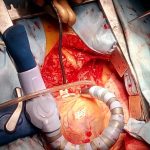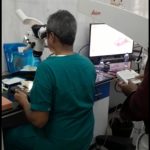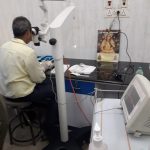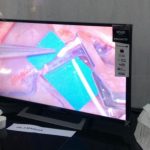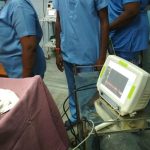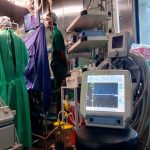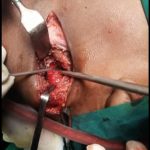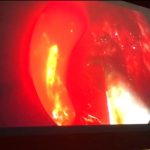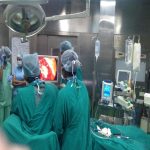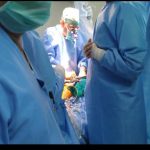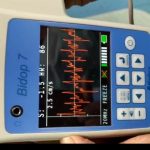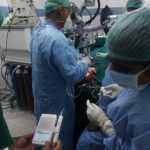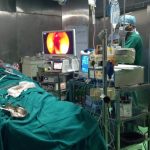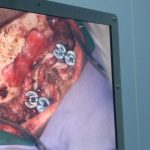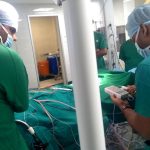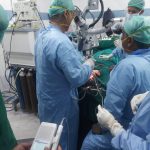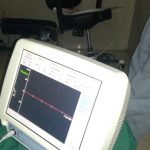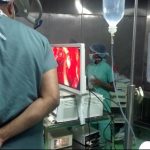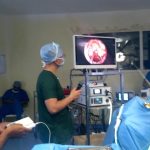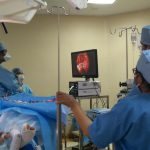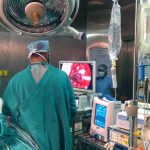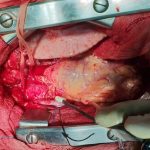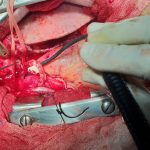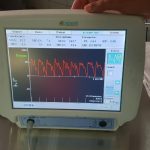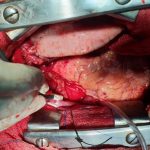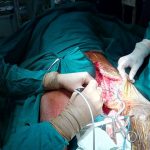
Doppler Surgical Device
SURGICAL DOPPLER
DVM 4500
Bi-directional Doppler with large colour touchscreen. Windows based simple touch operation. 2 probe combinations for 4, 5, 8, 10, 20MHz, & PPG. 30 waveform memory & USB interface. PDF and DICOM Export available for USB flash memory. Downsized design with high speed CPU & FFT analysis. PPG probe (Option)..
Features:
- 10-inch Large Colour Touchscreen
- High speed CPU & FFT Analyser
- Interchangeable probe 4, 5, 8, 10 and 20 MHz
- Light weight & Downsizing body
- Internal 30 waveform memory
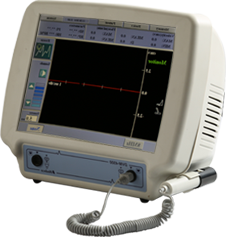
Wave form mode
- Spectrum, Max & Mean
- ZCC (Zero Cross Counter)
Velocity range (FFT)
- 4MHz 5MHz 8MHz
- 6-240 5-200 3-120 [cm/s]
- 10MHz 20MHz
- 2.5-100 1.5-50 [cm/s]
Vessel diameter
- 0.1 to 20mm
- PPG options
- Exporting to PDF and DICOM files with USB flash memory
Application
- Vascular Surgery
- Neurovascular Surgery
- Cardiothoracic Surgery
- Transplant Surgery
Diagnostic ratio determinations
- Peak, Mean & end diastolic
- Middle cerebral artery monitor
- Intra-operative volume flow documentation
- Post-operative evaluations
- Post-processing wave form analysis
- Venous compression studies
SURGICAL PROBES
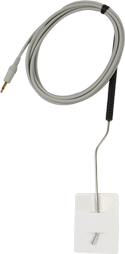
NRP PROBE 10MHz/20MHz
NRP 10MHz/20MHz Surgical probe is compatible with Hadeco Bidirectional Dopplers Minidop ES100VX, Bidop ES100V3, Bidop 7, Smartdop45.
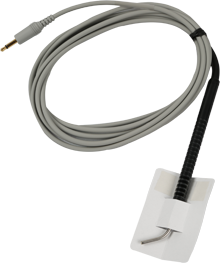
CRP PROBE 10MHz/20MHz
CRP 10MHz/20MHz Surgical probe is compatible with Hadeco Bidirectional Dopplers Minidop ES100VX, Bidop ES100V3, Bidop 7, Smartdop45.
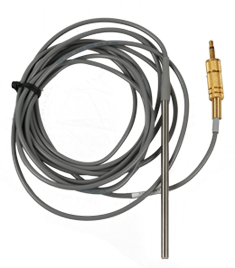
VRP PROBE 10MHz
VRP 10MHz Surgical probe is compatible with Hadeco Bidirectional Dopplers Minidop ES100VX, Bidop ES100V3, Bidop 7, Smartdop45.
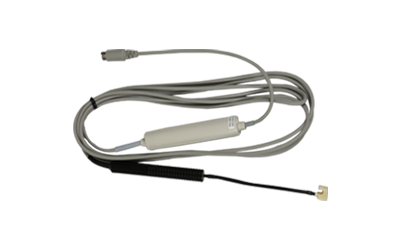
TUCKING PROBE 10MHz (3,4,5mmDia)
Surgical Tucking probe 10MHz (3,4,5mmDia) is compatible with Hadeco Bidirectional Doppler Blood Volume flow meter Model DVM 4500.

NP PROBE 10MHz flexible (2mm Dia)
NP10M2S8AF-2mm Dia flexible surgical probe is compatible with Hadeco Bidirectional Doppler Blood Volume flow meter Model DVM 4500.
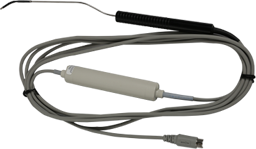
NP PROBE 20MHz flexible (1.2mm Dia)
NP20M12S8AF-1.2mm Dia flexible surgical probe is compatible with Hadeco Bidirectional Doppler Blood Volume flow meter Model DVM 4500.
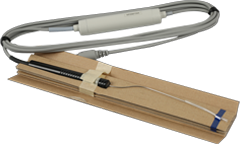
NP PROBE 20MHz Bayonet Ultra-thin (0.8mm Dia)
NP20M1S8A-0.8mm Dia flexible surgical probe is compatible with Hadeco Bidirectional Doppler Blood Volume flow meter Model DVM 4500.
STERILISATION PROCEDURE
METHOD 1 (ETO)
CLEANING
Probes must be cleaned to remove contaminating substances prior to sterilization. After each use, perform initial cleaning within the sterile field by wiping the probe free of blood and body fluids. Then, pass the probe out of the field. Disconnect the probe (and any adaptor) from the Doppler unit, clean the probe tip and housing thoroughly with a mild soapy solution, a soft cloth with an enzymatic cleaning solution, or an alcohol-based wipe. If using an enzymatic cleaning solution, wipe the probe again using mild soapy water or an alcohol-based wipe. Do not soak. Complete preparation for sterilization in accordance to hospital procedure using an approved probe cleaning agent.
STERILIZATION 80%
It is recommended that the intraoperative and laparoscopic probes be gas sterilized before each use with ethylene oxide (ETO) gas. The suggested mixture ratio is ETO gas – 20%, CO2 gas – 80%. Exposure time should not be less than 1 hour and 45 minutes at a pressure of 0.75 to 0.8Kg/cm2 and a temperature of 50° to 60° C. To achieve a Sterility Assurance level (SAL) of 10-6 (the recommended minimum for direct contact with blood), an exposure time of 3 hours and 30 minutes is necessary. A biological indicator strip should be placed in the load to verify the effectiveness of the cycle selected.
WARNING
Do not sterilize the Doppler probes listed above by steam autoclaving. Steam sterilization is likely to damage the plastic probe tip and piezo-electric crystals. Utilize Koven/Hadeco probe number ACP-08 for steam autoclaving. Do not use an automatic washer/disinfector. Temperatures will cause probe electronics to melt.
AERATION
Follow hospital requirements with regard to aeration time to allow residual ETO gas to dissipate. The minimum recommended aeration time is 8 hours at 60° C, 40% to 60% humidity with an air change (ventilation) frequency of 25 times per hour. Note: aeration time should meet institution and FDA guidelines.
AERATION
During the examination, fluid coupling must be maintained for proper signal reception. If needed, irrigate the incision or laparoscopic portal with sterile saline to insure adequate coupling. Use of sterile gel is acceptable in all areas except the brain.
CONTRAINDICATIONS: Hospital policy takes precedence over this protocol.
Failure to use approved cleaning & sterilization procedures may void the warranty
METHOD 2 (STERRAD)
CLEANING
Probes must be cleaned to remove contaminating substances prior to sterilization. After each use, perform initial cleaning within the sterile field by wiping the probe free of blood and body fluids. Then, pass the probe out of the field. Disconnect the probe (and any adaptor) from the Doppler unit, clean the probe tip and housing thoroughly with a mild soapy solution, a soft cloth with an enzymatic cleaning solution, or an alcohol-based wipe. If using an enzymatic cleaning solution, wipe the probe again using mild soapy water or an alcohol-based wipe. Do not soak. Complete preparation for sterilization in accordance to hospital procedure using an approved probe cleaning agent.
STERRAD STERILIZATION SYSTEM GUIDELINES
The probes listed above may be sterilized with the Sterrad 100S, Sterrad 200, Sterrad NX and/or Sterrad 100NX (where indicated) sterilization systems (see charts above). The general processing instructions in the “Sterrad 100S, Sterrad 200, Sterrad NX and/or Sterrad 100NX Sterilization System Operator’s Manual(s)” should be followed. Probes must be cleaned to remove contaminating substances prior to sterilization. After each use, perform initial cleaning within the sterile field by wiping the probe free of blood and body fluids.
STERILIZATION
Per recommended Sterrad 100S, Sterrad 200, Sterrad NX and/or Sterrad 100NX procedures using a Sterrad brand or Sterrad compatible trays.
WARNING
Sterilize according to instructions for the Sterrad 100S, Sterrad 200, Sterrad NX, and/or Sterrad 100NX Model(s). Do not sterilize the Doppler probes listed above by steam autoclaving. Steam sterilization is likely to damage the plastic probe tip and piezo-electric crystals. Utilize Koven/Hadeco probe number ACP-8 for steam autoclaving. Do not soak or submerge the probe in liquid. Do not use Cidex. Do not use an automatic washer/disinfector. Temperatures will cause probe electronics to melt.
Failure to use approved cleaning & sterilization procedures may void the warranty.
VIDEO GALLERY
FAQ
APPLICATIONS OF KODYS VASCULAR DOPPLERS IN PLASTIC SURGERY
1. Why Plastic Surgeon have to buy Bi-directional Doppler ?

Bi-directional Doppler measures presence of blood flow by Doppler Shift and distinguish both positive and negative direction of Blood flow.
Using this Doppler the examining doctor can recognize the blood flow directions away from the probe or towards the probe. So, Its called Bi-directional Doppler.
It uses Out phaser technology, These devices simultaneously separate forward and backward flow signals by comparing phases and pass on these signals by two separate channels.
This results in the artefact free registration of arterial signals which have venous signals super imposed on them and vice versa.
These devices are well suited to qualitatively assess blood flow as long as the examiner only uses secondary parameters such as shape of the curve, direction of flow or diastolic deflection.
2. How it will be benefiting clinically using the VRP 10 Intraoperative Probe?

It is a surgical use probe and offers a sensitive depth of penetration of (0-5 mm) in and around the place of assessment. This is ideal for surgeon who wants greater accuracy in Doppler.
APPLICATIONS OF KODYS VASCULAR DOPPLERS IN NEURO SURGERY
1. What is the clinical benefit for using Neurovascular Doppler Minidop ES100VX with Intraoperative Probe 10 MHz and 20 MHz ?

Minidop is a Doppler having Multi-Frequency Compatibility like 10 and 20 MHz All having Different depth of penetration like 0-5 mm and 0-3 mm. The more frequency the higher the sensitivity of flow signals and lower the depth of penetration and less frequency the lower the sensitivity of flow signals and higher the depth of penetration.
In Neurosurgery, this probe is essential to trace the location of carotid artery in Pituitary tumor decompression procedure or to find the patency assessment before and after the clipping of aneurysm.
This Doppler is very suitable for a Neurosurgeon as it is having higher sensitivity and accuracy in detection of flow signals or location of artery or vein.
2. What is the extra clinical benefit from bidop 100V3 with intraoperative probes 10, 20mhz?

Waveform of Unidirectional Doppler without X-Y Axis

Waveform of Bidirectional Doppler with X-Y Axis
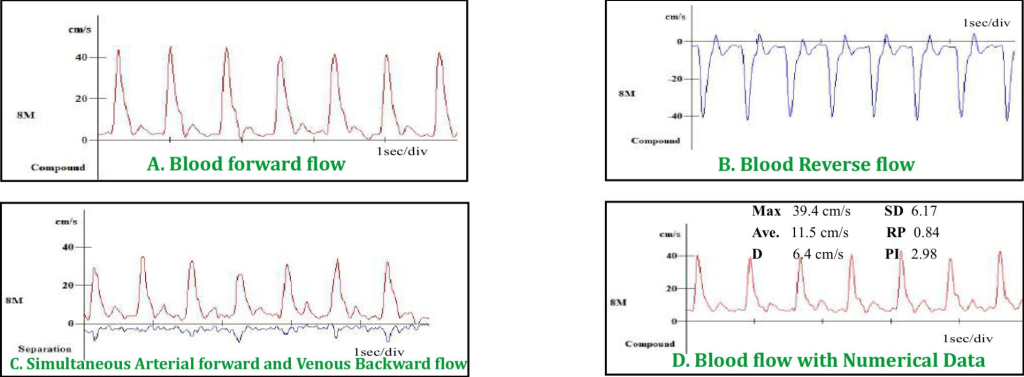
Bidop is a Bidirectional Doppler having a LCD Display which shows Numerical parameters such as Maximum Velocity (cm/s), Average Velocity (cm/s), Diastolic Velocity (cm/s), Systolic to Diastolic Ratio (SD), Resistance Parameter (RP), Pulsatility Index (PI) and Average and Maximum volume (ml/min). This is the most benefitable clinical details for observing the flow characteristics and recording the same.
3. What is extra clinical benefit from Bidop7 with 10mhz and 20mhz intraoperative probe comparatively 100V3 with intraoperative probe?

Bidop 7 is very similar to Bidop and has all the features of Bidop Es100v3.Extra Clinical Benefit It has color display with bigger speaker and inbuilt battery
4. How SD 45 with intraoperative probe nrp10, 20mhz is unique comparatively above minidop bidop, bidop7 with intraoperative probes?

Smartdop 45 is very similar to Bidop and has all the features of Bidop Es100v3.
Extra Clinical Benefit
It has bigger speaker and inbuilt battery with thermal printer.
S. No | Parameters | Minidop ES100VX | Bidop ES100V3 | Bidop 7 | Smartdop 45 |
1 | 8 MHz Bidirectional Probe | ✔ | ✔ | ✔ | ✔ |
2 | 10 MHz VRP, NRP, CRP and LRP Intraop Doppler Probes for Plastic, Neuro, Cardiac and Laparascopic Applications | ✔ | ✔ | ✔ | ✔ |
3 | 20 MHz NRP Intraop Doppler Probe for Neuro Applications | ✔ | ✔ | ✔ | ✔ |
4 | 2 MHz Probe | ✔ | ✔ | ✔ | ✔ |
5 | Precordial Doppler Probe for Air Emboli Monitoring | 🗶 | ✔ | 🗶 | 🗶 |
6 | 9V Alkaline Battery | ✔ | ✔ | ✔ | ✔ |
7 | Waveform with Display of Numerical parameters such as Velocity (cm/s), Volume (ml/min), Pulsatility Index, Resistance Parameter, Systolic to Diastolic Ratio | 🗶 | ✔ | ✔ | ✔ |
8 | LCD Display | 🗶 | ✔ | 🗶 | ✔ |
9 | Color Display | 🗶 | 🗶 | ✔ | 🗶 |
10 | Inbuilt Battery | 🗶 | 🗶 | ✔ | ✔ |
11 | Inbuilt Printer | 🗶 | 🗶 | 🗶 | ✔ |
5. How better performance compare with all other 4 models and how I will get clinical benefits?
Department | Applications | |
Neurosurgery | Aneurysm Clip / Bypass Surgery / Carotid endarterectomy / Tumorectomy / Pituitary Tumor Decompression
| |
Cardiovascular Surgery | Bypass Surgery / Detection of peripheral blood flow after surgery / Abdominal Aortic Aneurysm / Effectiveness of treatment of varicose veins / *Blood flow meter for tubing (For artificial hearts, dialysers) applicable with HD-800
| |
Oral Surgery | Blood flow confirmation of lip and cleft palate operation |
|
Urology and Nephrology | Varicocele / AV Shunt | |
Plastic Surgery | Perforator flap assessement and Transplantation | |
Orthopedic Surgery | Determination of PAD and Spinal Stenosis | |
Digestive Surgery | Identification of blood vessel during Laprascopic Surgery | |
Department | Applications | |
Medical Emergency Centre | Blood pressure measurement / confirmation of peripheral blood flow during extracorporeal circulation |
|
Obstetrics and Gynacology | Detection of fetal heart beat | |
Cardiovascular Department | Diagnosis of PAD/ABI testing | |
Department of Anaesthesiology | Blood flow confirmation before and after surgery | |
Pediatrics | Blood pressure measurement / Identification of blood vessel before surgery | |
Veterinary | Blood pressure measurement of animals/ Monitoring of peripheral circulation during surgery | |
 kodymedical@gmail.com
kodymedical@gmail.com +91-9380223396
+91-9380223396 My Account
My Account
